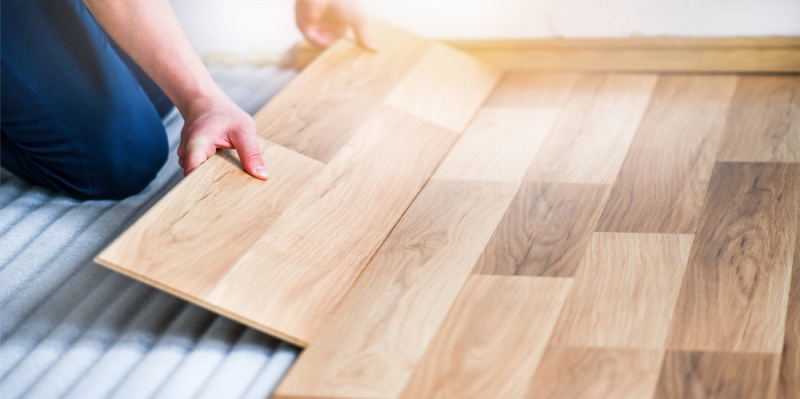Vinyl vs Laminate Flooring: A Comprehensive Comparison
When it comes to choosing the right flooring for your home, there are numerous options available. Among them, laminate and vinyl flooring are two popular choices that offer durability, affordability, and a wide range of design options.
Understanding the differences between vinyl flooring vs laminate is crucial in making an informed decision. In this blog, we will compare vinyl plank vs laminate flooring pros and cons to help you determine which one is the best fit for your needs.
Laminate Flooring:
Laminate flooring is a synthetic flooring material that consists of multiple layers, including a high-density fiberboard (HDF) core, a photographic layer, and a protective wear layer. It is designed to mimic the look of natural materials, like hardwood or stone.
Laminate flooring offers durability, affordability, and easy installation, making it a popular choice for homeowners looking for a cost-effective and visually appealing flooring option.
Pros:
-
Authentic appearance: Laminate flooring is designed to mimic the look of natural materials, such as hardwood or stone. With advanced printing techniques, laminate floors can replicate the textures, grains, and colors of these materials, providing an authentic aesthetic at a lower cost.
-
Durability: Laminate flooring is known for its durability and scratch resistance, making it a suitable choice for high-traffic areas like living rooms and hallways. It can withstand the impact of heavy furniture and resist the wear and tear of everyday use.
-
Easy installation: Laminate flooring is typically installed using a floating floor method, which means it doesn't require adhesive or nails. The planks or tiles interlock with each other, making the installation process quick and straightforward.
-
Cost-effective: Laminate flooring is generally more affordable compared to natural materials like hardwood or stone. It offers a budget-friendly alternative while still providing a similar aesthetic appeal.
Cons:
-
Limited repair options: Unlike natural materials, laminate flooring cannot be sanded or refinished. If the planks get damaged or scratched, they usually need to be replaced entirely.
-
Environmental impact: Some laminate flooring products may contain harmful chemicals like formaldehyde. It is important to choose low-VOC (Volatile Organic Compound) options to minimize the environmental impact.
Vinyl Flooring:
Vinyl flooring is a type of synthetic flooring material made from layers of PVC (polyvinyl chloride) and other additives. It comes in various forms, including luxury vinyl tiles (LVT) and luxury vinyl planks (LVP), which mimic the appearance of natural materials like hardwood or stone.
Vinyl flooring is known for its durability, moisture resistance, and wide range of design options, making it a popular choice for both residential and commercial spaces.
Pros:
-
Versatile design options: Vinyl flooring offers a wide range of design choices, including luxury vinyl tile (LVT) and luxury vinyl planks (LVP). These options can replicate the appearance of various natural materials, such as hardwood, stone, or ceramic tile, with impressive accuracy.
-
Moisture resistance: Vinyl flooring is highly resistant to moisture, making it suitable for areas with high humidity or potential water exposure, such as bathrooms, kitchens, or basements. It can withstand spills and humidity without warping or swelling.
-
Easy maintenance: Vinyl flooring is easy to clean and maintain. Regular sweeping or vacuuming, along with occasional damp mopping, is usually sufficient to keep it looking pristine.
-
Comfort and noise reduction: Vinyl flooring provides a cushioned surface underfoot, offering a more comfortable experience compared to harder materials like hardwood or tile. It also helps to reduce noise transmission, making it a good choice for multi-story homes.
Cons:
-
Wear layer durability: Vinyl flooring consists of wear layers that protect the surface from scratches and stains. However, the durability of these wear layers can vary depending on the quality of the product. Thicker wear layers tend to offer better resistance to wear and tear.
-
Environmental impact: While vinyl flooring is more eco-friendly than it used to be, some types of vinyl flooring may still contain PVC and other potentially harmful chemicals. Opting for low-VOC and phthalate-free options is recommended to minimize the impact on indoor air quality.
-
Limited repair options: Like laminate flooring, vinyl flooring cannot be refinished or repaired easily. Damaged areas usually require replacement, which can be a bit more challenging due to the adhesive used during installation.
Laminate vs Vinyl Flooring Cost Comparison

When it comes to the cost, both laminate and vinyl flooring offer more affordable options compared to natural materials.
However, the price can vary depending on factors such as the quality of the product, thickness, design, and brand. Generally, vinyl flooring tends to have a slightly lower price per square foot compared to laminate flooring, but it's essential to consider the specific characteristics and features you desire within your budget. Vinyl and laminate can both be good choices.
The Bottom Line
In conclusion, laminate and vinyl flooring are both attractive and practical options for homeowners. Laminate flooring provides an authentic look with excellent scratch resistance, while vinyl flooring offers a versatile design range and superior moisture resistance.
When making a decision, consider the specific needs of your space, such as the level of moisture, traffic, and your budget. With the right choice, you can achieve a beautiful and durable flooring installed that suits your style and lifestyle.
Shop our collection of laminate and vinyl flooring

-Copy-1.jpg)